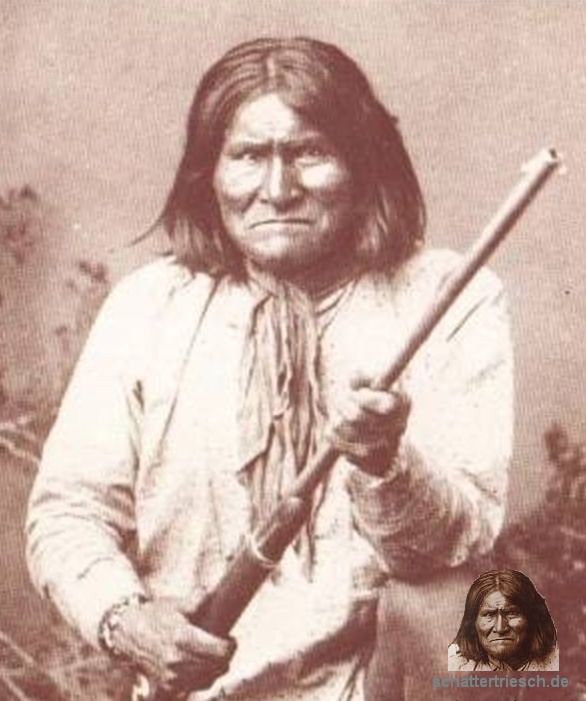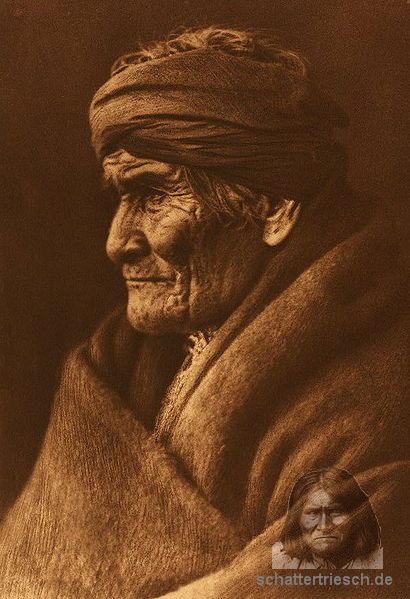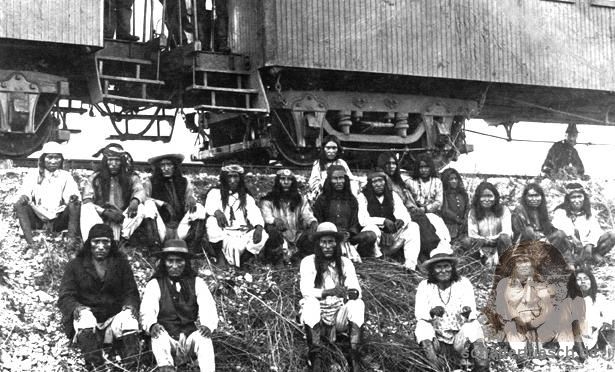|
Später
ging er dann nach Amerika wo er bekannt wurde. Dieser Artikel über
ihn wurde in einer amerikanischen Zeitung gefunden.
Public enemy by 1885. (Mitchell
Daily Republican, Friday, February 12, 1886)
A bad indian
When Hon. Carl Schurz was secretary of the interior, in one of his reports
he characterizes the Apaches as "bad Indians." That was several years
ago. They have not improved in behavior since. For a year and a half Chief
Geronimo and his band of Apaches have been terrorizing the southwest. The exact
number of braves he had with him cannot, of course, be exactly known, but it
was between twenty and thirty. Over a tract of country as largo as a good-sized
state these redskins have been roaming, stealing cattle, horses and food, and
murdering and destroying. They knew the country like a fox. They were brave,
cunning, remorseless and untiring. After committing a robbery or a murder they
fled like the wind, and took refuge in some of the mountain fastnesses they
knew so well. If pursued too hotly, a few hours' fast and furious riding took
them over the border into old Mexico,
where they were safe from the United
States soldiery, at least for the time. They
were well wined and well mounted. For months, years even, they have been a red
vengeance on our border.
It was the task of the lamented Capt. Emmet Crawford to pursue and
capture these fiends. Month after mouth he followed them through waterless
deserts, through sand and cactus spines into rocky into rocky canyons and over
lava beds, till last he ran them down in Mexico.
 Latterly
the Mexican and United States
governments have been co-operating to rid both countries of these pests, Two
forces, one of Mexican the other United States soldiers, hemmed
Geronimo in between them Jan. 10. Geronimo and all his force were captured, but
the brave and tireless Capt. Crawford was killed. Latterly
the Mexican and United States
governments have been co-operating to rid both countries of these pests, Two
forces, one of Mexican the other United States soldiers, hemmed
Geronimo in between them Jan. 10. Geronimo and all his force were captured, but
the brave and tireless Capt. Crawford was killed.
He had with him as guides a company of friendly Apache Indian scouts. The
force of these was larger than Geronimo's own. They were the motliest crew that
ever started out soldiering. They were taken over the Southern Pacific railway
to a point as near the scone of hostilities as possible. They were locked in a
car to themselves with a United
States lieutenant.
"I suppose you know," said the train conductor to a newspaper
correspondent, "that to give them red devils a drink of whisky all around
would be to turn into hostiles in hour."
The motley warriors had been given high hats, out of which they had,
without exception, torn the crown, so that their hair stood raggedly out at the
top. Some of them wore six shirts apiece, and one, the envied of all gloried in
drapery made of a red cotton tablecloth.
Geronimo, too, is accustomed to adorn his ugly person in this style. He
wears a hat draped with a lady's sash of bright color. Now that he has been
caught, it will be a question what to do with him. He and his band belong to
what is called the Chiricakua branch of the Apache tribe. The White Mountain
Apaches are friendly.
The Apaches used to be the white man's friend and ally, When the truth
of history shall be known it will be found that there arc two sides to thy
outbreak of 1885. It was not for nothing that Geronimo and his band of scalping
savages took the warpath. It was take vengeance for wrongs, and deep wrongs
their tribe had suffered at the hands of the conquering white. Breaches of
faith go down no better with a savage mind than with a civilized one.
Since Geronimo has been captured let us hope that even the Apaches may
be civilized. The Sioux were as bad as they less than twenty-five years ago,
and the Sioux are now among the best of good Indians.
And another, less constructive and positive approach to the capture of
Apache chief Geronimo, from the Indiana
Progress, Thursday, February 11, 1886
The Apache Chief Geronimo and the surviving members of his band, who
recently killed by torture and inhuman butchery 170 persons, many of whom were
women, are now in custody. The people of Arizona
and New Mexico
are very indignant, and will oppose the usual course of the military
authorities in allowing them to return to their reservations unpunished.
Petitions will be sent to Washington,
asking that Geronimo and his followers be tried for murder under the laws of
the territories where his crimes were committed.
Here is another article that appeared on Friday, April 23, 1858 in the The
Athens Messenger under the title "The Dona Ann Affair."
Dr. M. Steck, United States
agent for the Apache Indians, arrived in Santa
Fe on Thursday evening last, looking well and hearty. We
learn from Dr. S. that the Indians of his agency are peaceably disposed, and
that no outrages have been committed by them since the Gila war. He officially
reports the revolting massacre of eight Apaches in Dona Ann county, on the 7th
of February, which we have heretofore noticed in the Gazette. In addition to
the brutal mutilation of the bodies of the women who were murdered, by cutting
off their breasts, tearing out their tongues, and slicing up their hearts,
another case occurred of equal brutality. An old Indian woman, at least 60
years of age, was shot through the body, stabbed in the back five different
times, and then suspended by one foot from the pummel of the saddle by a rope,
and dragged at the full speed of the horse down a hill for 400 yards. - She was
then loosened and left on the ground for dead. After the Mexicans had left, the
other Indian women gathered around her, and ascertaining who were present, and
that her tormentors had gone, she arose and walked off with her companions!
While this wholescale butcher is the most brutal that has ever been
perpetrated upon the Apaches by the people of the Mesilla, it is but one of the
many outrages committed. On various occasions heretofore, they have murdered
Indians of this tribe without provocation; and not one of the murderers have
ever been brought to justice.
Curiously enough, it is hard to find news reports from 1858 about the
massacre committed against the tribe of Geronimo. Newspapers emphasized the
killing of whites much more at that time. Among the many hate-monging reports
of whiet families murdered by Apaches, only a few dared to give account of the
reasons behind the brutality of the "redskins".
The following article contains the first notices of the vicious Apache
Chief Geronimo, in relation to his succession to the leadership of his tribe
and negotiations about a hostage. The photograph of Geronimo is not part of the
original article.
Charley McComas
DEMISO, N. M., October 11.-D. H. Leroy and George Wilson, who left here
September 19th with a Mexican merchant for the purpose of rescuing Charley
McComas, returned to-day. Arriving at Casa Grande they found that Juh had been
drowned, while drunk, on the 21st of September, by falling off his horse into
the Casa Grande River.
The Indians elected Geronimo chief, ignoring Juh's son. This made a disturbance
among the Indians, audit was difficult to treat with them, and matters were
more complicated by the massing of Mexican troops, and attempts by them to get
the Indians drunk preparatory to a massacre.
Finally communications were opened with Geronimo, who was anxious to
trade for cartridges and offered to give a horse for every ten. His brother and
men, he said, were en route for the San
Carlos agency to get cartridges and recruits. After
two interviews the subject of the captive boy was broached and according to Mr.
Leroy the child is certainly alive, and with Juh's widow. Geronimo finally
appointed an interview at a stated place, where he met Wilson and an
interpreter. Wilson
had nearly one hundred bolts of calico and some other articles which he was
ready to offer for the boy, with promises of 200 cartridges on
final delivery. Geronimo said that Juh's widow did not want to give the
child up but that he would compel her to if he could get the cartridges in
exchange. While the talk was proceeding one of Governor Torres' chief scouts
was seen approaching, and Geronimo, fearing treachery, broke up the interview,
saying, "You go to your house; I to my camp. "Wilson, in alarm lest he should not get the
boy, offered to go with Geronimo, but was not allowed to do so.
Subsequent attempts to treat for the boy failed, owing to the proximity
of Mexican troops and the local authorities interfering to prevent Leroy and
Wilson from meeting the Indians. Leroy says that Geronimo claims to have l50
warriors. He counted seventy-five at one of the interviews.
There are 600 Mexican troops at Casa Grande. Leroy and Wilson are
well-known citizens, and their report is worthy of credence. Further steps will
be immediately taken for the rescue of the child.
A few weeks after Geronimo's election to Apache Chief, and the failure
of the negotiations, the indians prove their viciousness.
Old Juh Alive.
Santa Fee, N. M,, Oct. 31- Advices from Deming say Juh, head chief of
the Apaches, is not dead, but is now raiding in southern Chihuahua, Jas. Lepas,
a Mexican who has a half brother with Chief Geronimo, reports that little
Charley McComas was recently killed by Indians. The Indians who have been
hovering around both sides the boundary line having been disappointed in
receiving reinforcements from the San
Carlos reservation, now split up into small raiding
parties, and a good many horses have been stolen from various places.
A typical article about the crimes of the Indians - many similar
articles appeared in contemporary newspapers every day.
Apache Indians on the Warpath
(...) The Apache Indians are again committing depredations in Sonora. On January 29
they killed two men and stole horses and cattle near Chinipas. On the 30th they
seriously wounded a Mexican vaquero near Tituachi, stole horses of American
prospectors and the stock of Leonard Gomez, Perfect of the Arispe district.
The authorities have sent a force in pursuit, but no news has been
received from them yet. The Apaches are believed to he crossing the border in
several places simultaneously. For the past few days they have been depredating
in the Sahuaripa district and killed Dolore Lopez and wounded Lorenza Melendez
near Baniosi. Several bodies of Mexicans have been found on the Mexican soil,
near the border.
At Maritana the Indians killed the same day Jesus Duarto, and another
near Chinavuachi. The mail carrier of the Sahuaripa route is missing, and is
believed to have been killed. Large numbers of cattle were stolen from Lospiedias
Delumbre. The Federal force is in pursuit and another force is seeking to head
off the marauders. Colonel Garcia, with a large force is also out.
Oklahoma City, Okla. - Maj. H. L. Scott,
representing the war department, and Lieut. Ernest Stocker, Anadarko agent,
representing the department of the interior, were appointed to select the new
homes for the 269 Apache prisoners of war held by the United States government at Fort Sill, Oklahoma.
The last session of congress granted liberty to these
Indians, after holding them prisoners of war for twenty-six years, and the
committee of two will select for them an open reservation somewhere in the
west, but the probabilities are that their new home will not be within the
boundaries of either New Mexico or Arizona. A reservation
in either of those states might incite in the savage Apache Indians a memory of
their forefathers' conquests and defeats, within those boundaries, and render
their reimprisonment necessary.
The Apache tribe is one of the few tribes that never
assimilated the white man's way of living, and since the year of 1858 have not
been on friendly terms with any member of the white race.
In that year one division of the six branches into
which the tribe is divided, went from the eastern line of Arizona, where they
were ranging, into Old Mexico on a trading expedition. When near the outpost of
the Kas-ki-yeh they camped, and, leaving their women and children, proceeded
toward Casa Grande. Citizens from that town met them and entered into a treaty
of peace with them, though the Mexican government had placed a price upon their
heads, paying $100 for a warrior, $50 for a squaw and $25 for a dead Indian
child.
While in Casa Grande, trading, Mexican soldiers took advantage
of their absence from camp and set up on the defenseless women and children,
killing al within camp. When the warriors returned in the evening the Mexican
soldiers opened fire upon them and the Apaches, being armed with bows and
arrows, were exterminated, excepting Geronimo, who at that time was a young
brave, and one other Apache. In this massacre Geronimo lost his wife and child,
and, according to his own statement made after he became a prisoner of war of
the United States,
he swore eternal hostility to all Mexicans.
Geronimo returned to Arizona and sought aid from the other five
Apache tribes, in seeking revenge on the Mexicans. The citizens of Casa Grande
sent him a disclaimer of all knowledge of the massacre of his people after they
had entered into the trading treaty with his band in Old Mexico, but Geronimo
could never understand how it was the citizens had no control over these acts
of the soldiers, and from that year until 1886 made annual raids upon the
settlements within 300 miles of the northern boundary of Mexico.
The Apaches, while on their excursions to Mexico, ran off some cattle that were in charge
of white cowboys, and shortly thereafter United States troops made their
appearances, and the Apaches always professed to believe they came in response
to the Mexican government's appeal for aid in exterminating the Apaches.
Geronimo died about eighteen months ago, and most of
the old race of warriors had preceded him to the grave, and now the general
government believes the younger generation can be once more trusted to run at
large on an open reservation.
The failure of the Apache Indians to assimilate the
ways of civilization which finally resulted in their becoming prisoners of war,
was no doubt due in a large measure to the ascendancy Geronimo had over the
members of his tribe, whom he kept constantly avenging the wrongs he and his
relatives suffered at the hands of the Mexicans and Americans.
|









